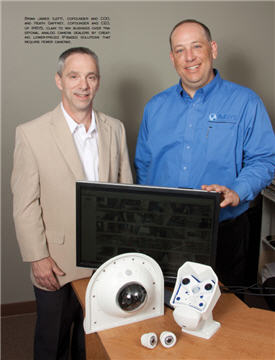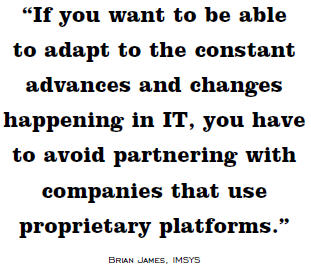Build Your Business On An IP Video Foundation
By The Business Solutions Network
Unlike larger competitors that are entrenched in analog video, this IT solutions provider’s decision to sell and support IP-based solutions is leading to another year of triple-digit revenue growth.

When I talk with IP video surveillance experts, as I did recently with Heath Gaffney, cofounder and CEO, and Brian James, cofounder and COO, of IMSYS, I like to learn about how they transitioned from selling analog video surveillance to IP video surveillance. Gaffney laughed at that question because IMSYS has sold only IP video surveillance since its inception nearly eight years ago. He then followed with, “When a prospect asks for a quote on an analog solution, we refer them to The Home Depot — even Walmart now sells only IP video equipment.”
Based on IMSYS’ position on never selling analog solutions, you might think the company would have to turn away some lucrative deals. But, looking at IMSYS’ revenue growth, which was up 150% in 2012 over 2011 and is tracking to be up 350% this year over last year, you quickly realize that this 10-person company is on to something. Recently, the solutions provider landed a $3.3 million project with the Bergen County, NJ, Sheriff’s Office, which further confirmed my hunch. After talking with Gaffney and James, I discovered a couple of things IMSYS does differently, which the average VAR or systems integrator and other solutions providers would do well to imitate.
Build Your Bundled Solution On An Open-Source Platform
Gaffney and James both came from Psion Teklogix, so when they started IMSYS they had a lot of knowledge about RFID and wireless technologies. They correctly anticipated, however, that to differentiate their business from other wireless and RFID companies, they would need to integrate RFID with other complementary technologies. “If you want to be able to adapt to the constant advances and changes happening in IT, you have to avoid partnering with companies that use proprietary platforms,” says James. “Even though that’s prevented us from working with some big-name video camera and VMS [video management software] vendors, we strongly believe it’s been an important part of our success.”

IMSYS put this strategy to work early on in its business. One of the first product integrations the solutions provider performed was a bundled offering that included active RFID tags and Mobotix IP video surveillance cameras, a solution that IMSYS would later rebrand as its IMSYS Presence Awareness System (IPAS). “We used the Windows .Net platform to create a deep, socket-level integration between the products,” recalls Gaffney. “This enabled us to offer an intelligent, rules-based video surveillance and tracking solution that became very appealing to companies and organizations in education, law enforcement, public safety, and retail.” For example, a police officer assigned to a courtroom can be outfitted with an active RFID tag. If the judge hands down a hard sentence to a felon, and the felon attempts to escape, the officer can press his RFID button, causing all the courtroom doors to automatically lock. At the same time, an alert is sent to the central control, which can see live video of the courtroom and determine if backup is needed. “Had we built this solution on a proprietary platform, we would have only been able to achieve a loose integration at best, which would have added extra button pushes, phone calls, and other manual processes that would have made the solution much less useful for the customer,” says Gaffney.
Innovate, Integrate, And Expand Your Video Surveillance Solution
As IMSYS developed a name for itself in law enforcement and public safety with its intelligent video monitoring solution, it talked with customers, attended trade shows, and read industry trade publications to look for additional areas where it could use its product. One innovation that resulted from its research was the concept of adding voice capabilities with its video solution. “From a technology perspective, adding voice capabilities is just one more application running on the IP network,” says James. “We already understood the importance of prioritizing packets and providing QoS [quality of service] from working with video, so it was a very short learning curve for us.” IMSYS once again found its new solution to be a hit with law enforcement. “Our law enforcement customers like this solution in their interrogation rooms because they can have more experts involved with an interrogation without having to have everyone physically in the room,” says Gaffney. “The person viewing the interview remotely can see every eyebrow twitch and hear Adam’s apple gulps or any other gestures that are an important part of the investigation process.”
Shortly after adding voice to its RFID-enabled video solution, IMSYS identified another challenge that many of its customers have, which is limited bandwidth. “One client was planning to dig up sidewalks and spend hundreds of thousands of dollars to run additional T1 lines, so that it could support its expanding IT infrastructure,” recalls James. “We did some research and found a wireless point-to-point solution could be a viable alternative to running the T1 lines, providing the customer with the same bandwidth performance at a small fraction of the cost of the T1 lines, plus the wireless network didn’t have any recurring costs like the carrier-owned T1 lines did.”
Helping its customers save money is one of the primary reasons IMSYS has been able to win so many large business deals, deals that often pit it against much larger competitors. According to Gaffney and James, many of these behemoths have been around for a long time and experienced their success when analog technology was all that was available. Now, they’re so entrenched in analog that they aren’t able to adapt to the times. The Bergen County, NJ, Sheriff’s Office project, which was mentioned earlier, is a good example of how IMSYS is able to beat out much larger competitors. When the police department sent out a bid for a video surveillance project, it had originally planned for a $5 million budget because of all the servers and switches and analog cameras it required. “With an IP-based solution we were able to accomplish the same thing with half as many cameras and half the infrastructure, which knocked $1.7 million off the price,” says Gaffney. “Even if an analog video surveillance dealer wanted to sell their analog cameras and other hardware at cost, it still couldn’t touch that cost difference.”
In addition to helping clients with front office technology to meet their business needs, IMSYS uses and sells the latest virtual server back end technology to drive its IPAS solution. Check out the sidebar on page 14 to learn more about this topic.
Continued Innovation And Changes Planned
Even though IMSYS already has a bundled solution that differentiates it from many of its competitors, which typically integrate no more than two technologies, the solutions provider continues to anticipate new technologies it can integrate with its IPAS bundle. “A couple of new technologies we’re considering are chemical sniffing sensors and facial recognition software,” says James. “The chemical sensors would be practical for gas companies and chemical manufacturers to use for safety reasons. If a gas leak or other harmful chemical leak occurred, the sensor could detect the problem before a human could, and the system could be programmed to alert authorities, shut off valves, and take other safety measures to save lives.”
With regard to facial recognition technology, IMSYS envisions this being used as the next evolution for law enforcement and public safety. “If a criminal was able to steal an officer’s ID card, for example, the facial recognition software could work as another safety measure to prevent the criminal from accessing a gun closet,” says James.
Another big move IMSYS has started is transitioning its business from a systems integrator into a software vendor and partnering with other systems integrators and VARs. Gaffney and James admit this will be a big change from what they’ve been doing the past eight years, but it’s been a goal of theirs from the beginning. “The thing we’ve always loved the most has been identifying market trends and building our product to address customers’ needs,” says Gaffney. “Making this transition will allow us to spend less time working in our business and more time working on our business.”

